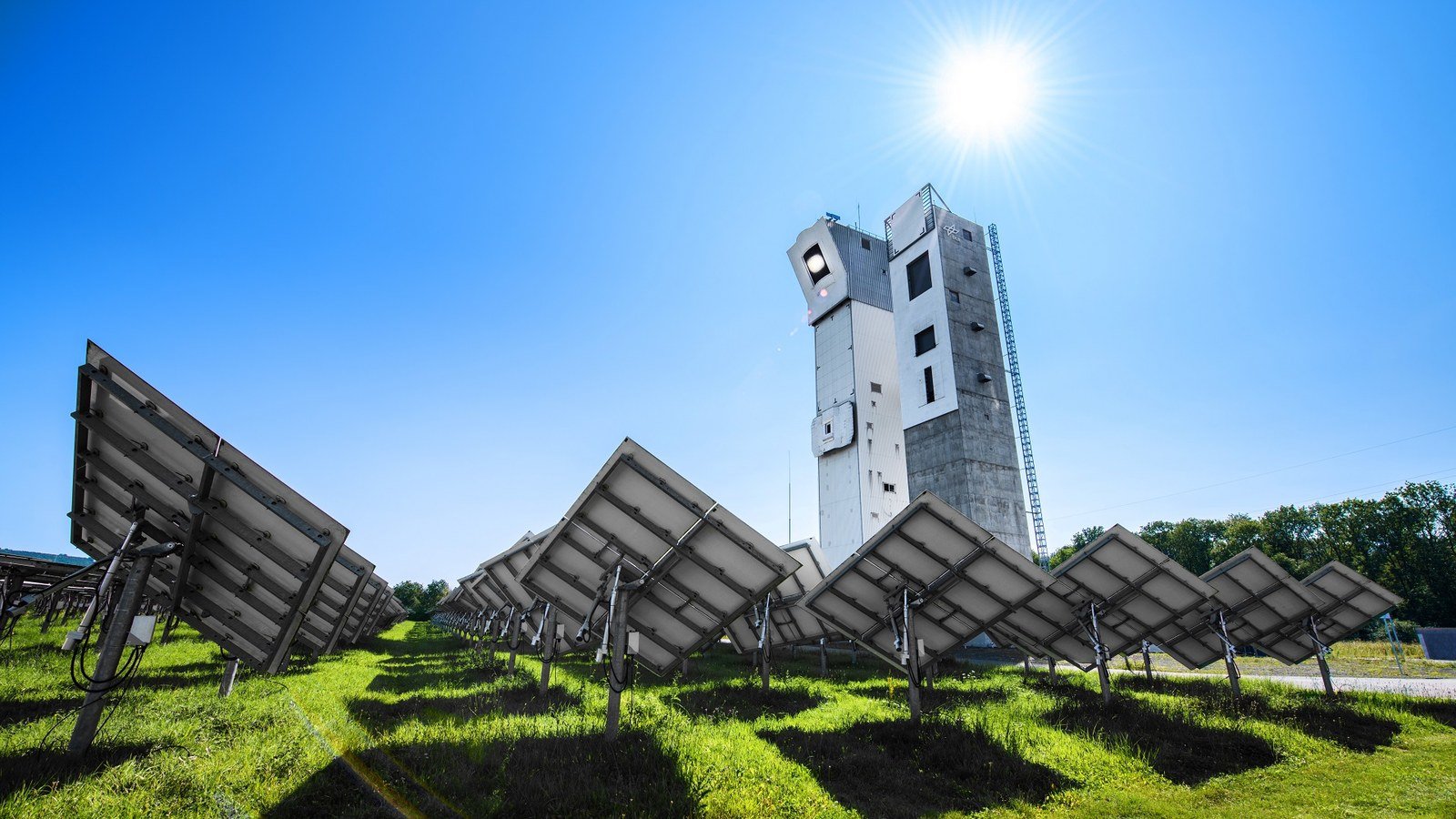Testsing and development of components and systems for commercial solar thermal power plants. The aim is to make solar thermal power plants more efficient. They also test processes for solar water splitting, the production of solar fuels and the use of solar heat in industrial processes.
More than 2,000 movable mirrors (heliostats) cover an area of around ten hectares in front of Jülich’s two solar towers. They catch the sunlight, concentrate it and direct it onto the two solar towers.
In the solar tower power plant, a volumetric receiver at the top of the tower absorbs the concentrated sunlight and uses it to heat the surrounding air to up to 700 degrees Celsius. A steam generator inside the tower uses this to heat water into steam, which drives a turbine that produces electricity via a generator.
https://www.dlr.de/en/research-and-transfer/research-infrastructure/solar-towers-juelich



Due to the inverse square law this would be way more efficient if the tower was in the center surrounded by the reflecting mirrors. Unless I’m missing something?
It seems like that would massively increase complexity - right now the energy is collected at one point, having it collected all around the tower means more leakage and way less maximum energy.
I think you need to use the entire distance from the sun, which means the few meters between the mirrors is a miniscule difference
How tall is the tower?
60 meter (200 ft).
That’s about a 20 story building. Very tall, but actually not as tall as i was imagining
It doesn’t really need to be tall i guess. Its only for the mirrors to be able to reflect the sunlight to the receptor.
Maybe it needs to be taller if there were more mirrors though. This is still experimental
I have no concept of how tall it should be for effectiveness, i just meant that from the pictures i thought it looked like 50 stories tall
For someone who knows nothing about electric generation, can someone ELI5 how this is different (good and bad) than solar panels?
I always felt solar panels are less efficient in large scale (archers vs panels on your house) but not enough to look into it.
I don’t think this is what they are directly aiming for with this specific one, but this general idea of a large field of reflectors and a central receiver can be built to store heat for a while. That lets you use solar power overnight
This sort of solar power generally doesn’t compete successfully with regular solar panels in cost, and obviously it can’t just be set up on a bunch of random roofs like panels can. Still, it’s potentially a very useful technology if someone does work out how to make it a bit cheaper or more efficient, and it still generates clean power in the process too
The link explains that this is experimental, and that they are both experimenting with turning water into steam, and then using the steam to generate electricity (I imagine this is kind of like steam engines right?), but they are also experimenting with splitting water, in order to make what they call sun-fuel (i expect this is just hydrogen?)
I imagine this is kind of like steam engines right
Yeah, exactly. That’s also how coal, gas, and nuclear power plants work too. Turns out that running steam through a turbine is just a really good way to make power.
i expect this is just hydrogen?
You actually can make other fuels with solar power too, and since they’re listing it separately from water splitting I think they might be doing that. It is possible to make hydrocarbon fuels out of CO2 and water (or mlre accurately, carbon monoxide and hydrogen) with the right combination of catalysts and energy. It’s an application of the Fischer–Tropsch process, which has traditionally just been used for converting coal or biomass into more useful forms. So if that’s what they’re doing, they’re taking carbon out of the air and hydrogen out of water and then combining those two into petrol and such, using solar energy for each step of the process
Great! Thanks!
Photovoltaic solar panels turn light directly into electricity. This thing bounces light to a place where it can be turned into heat. The heat boils water, and the steam turns a turbine. The spinning motion is converted into electricity.
Steam power is a lot older than photovoltaic cells. Nearly every other form of power generation is basically just spinning a turbine. Nuclear, coal, and geothermal heat up steam. Hydro and wind get nature to spin the turbine. With steam power, all your problems with efficiency are mechanical. How do you reduce friction in the bearings? How do you get more power out of the steam? Whereas developing more efficient PV cells requires a deep understanding of subatomic physics. On the other hand, it’s difficult to think your way out of physical limits on steam power, like where does the waste heat go? The future of PV probably still has surprises left for us.
Also it sounds like the energy can be stored and used even when there is no sun! Lastly, they also mention experiments with splitting water into fluel, so i expect this is just splitting water into hydrogen right?



